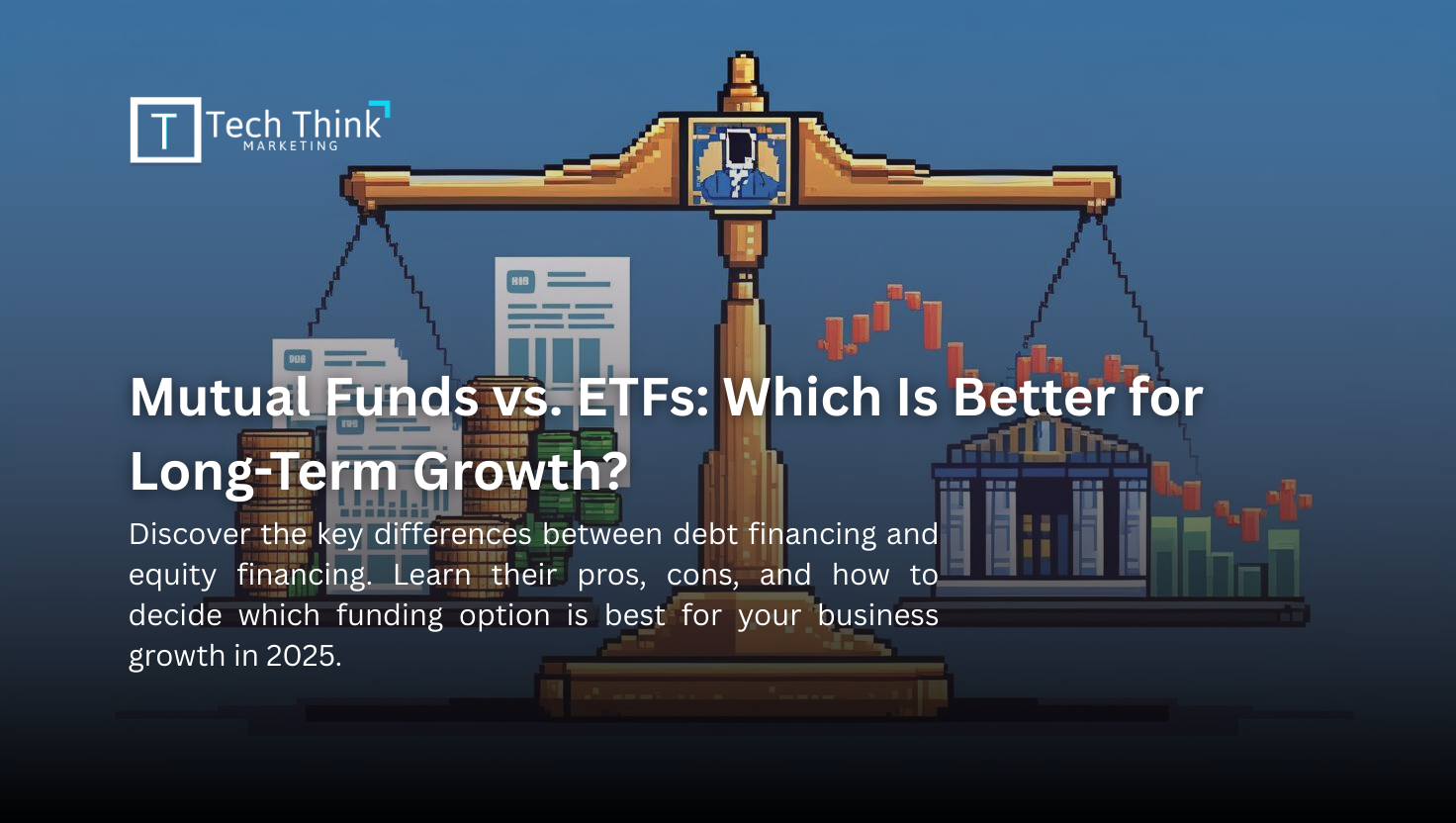Office No. 608, Lunkad Sky Station, Viman Nagar Road, Pune, Maharashtra 411014, India
Phone: +1 213-261-0597
contact@techthinkmarketing.com
Mutual Funds vs ETFs is one of the most powerful ways to make money over time. For long-term investors, the two most popular alternatives are mutual funds and stock market traded funds (ETFs). Both allow you to invest in a diverse portfolio of assets, but they are different in structure, costs and flexibility.
So, what is better for long -term development? The answer depends on your goals, risk tolerance and investment style. Let’s break that step by step.
Table of Contents
ToggleWhat Are Mutual Funds?
Mutual Funds vs ETFs mutual fund is a total investment vehicle where money from many investors is combined to buy a portfolio of shares, bonds or other assets. They are administered by professional fund managers who buy and sell.
Types of mutual funds:
- Equity Mutual Funds (Share Centric)
- Debt mutual fund
- Balance/Hybrid Fund (mixture of stock and bond)
- Index Fund (Track Market Index such as S & P500, Nifty 50)
Mutual Funds vs ETFs buy or sell equity units on net assets (NAV), which is calculated once every day after getting closer to the markets.
What Are ETFs?
Mutual Funds vs ETFs An exchange-traded fund (ETF) is also a pooled investment vehicle, but it trades on stock exchanges just like individual shares. ETFs usually track an index, sector, or commodity.
- Types of ETFs:
- Equity ETFs (stock market indexes)
- Bond ETFs
- Sector ETFs (tech, healthcare, energy, etc.)
- Commodity ETFs (gold, silver, oil, etc.)
ETFs offer the flexibility of buying and selling throughout the day at market prices, making them highly liquid.
Key Differences Between Mutual Funds and ETFs
| Feature | Mutual Funds | ETFs |
|---|---|---|
| Trading | Bought/sold at end-of-day NAV | Traded like stocks throughout the day |
| Management | Actively or passively managed | Mostly passively managed (index-based) |
| Costs | Higher expense ratios due to fund managers | Lower expense ratios |
| Minimum Investment | Often requires minimum investment (e.g., $500 or more) | Can buy as little as 1 share |
| Liquidity | Less liquid (end-of-day transactions) | Highly liquid (intra-day trading) |
| Tax Efficiency | Less tax efficient | More tax efficient due to “in-kind” creation/redemption |
| Suitability | Long-term investors who prefer professional management | DIY investors who want flexibility and lower costs |
Pros and Cons of Mutual Funds
Advantage
Mutual Funds vs ETFs Management – Fund Manager chooses active property.
Convenience ideal for investors who want hands-off approaches.
Systematic investment plans (SIPS) are good for disciplined, long-term investment.
Mutual Funds vs ETFs Variation—A wide range of the fund is available.
Loss
High fees—management fees and expenditure rates can reduce the return.
Low control—investors cannot act directly during the day.
Tax inhibition—selling properties in the fund can trigger taxable incidents.
Which Is Better for Long-Term Growth?
When it comes to long-term wealth building, both mutual funds and ETFs can play important roles. The better option depends on your priorities:
- Choose Mutual Funds if:
- You prefer professional fund management.
- You like SIPs (systematic investment plans).
- You don’t want to worry about daily market movements.
- You’re investing in actively managed strategies where managers try to beat the market.
- Choose ETFs if:
- You want lower fees and higher cost efficiency.
- You prefer index investing (tracking the overall market).
- You want liquidity and flexibility to trade anytime.
- You value tax efficiency for long-term compounding.
Performance Comparison: Mutual Funds vs. ETFs
- Actively managed mutual funds sometimes outperform the market in the short run, but research shows that most fail to beat index funds (ETFs) over the long run.
- ETFs, especially index-based ones, often deliver market-matching returns at lower costs, making them attractive for long-term investors.
- For growth-focused investors, ETFs usually offer a cost advantage that compounds significantly over 10–20 years.
Real-World Example
- Mutual Fund Example:
An investor contributes $500 per month to an actively managed equity mutual fund through a SIP. Over 20 years, even with higher fees, the investor benefits from discipline and compounding. - ETF Example:
Another investor buys low-cost ETFs that track the S&P 500 or Nifty 50. By holding for 20 years, the investor minimizes fees and enjoys market-matching returns, often outperforming higher-cost funds.
Hybrid Approach: Using Both
Many investors use a blend of mutual funds and ETFs for diversification:
- Mutual funds for SIPs and professional management.
- ETFs for passive, low-cost, long-term exposure to markets.
This strategy allows you to enjoy the best of both worlds—growth potential + cost efficiency.
- Do I prefer active management or low-cost passive investing?
- Am I comfortable with daily market fluctuations (ETFs) or do I prefer simplicity (mutual funds)?
- What are the fees and expense ratios involved?
- Do I want the flexibility to trade anytime, or am I focused on long-term holding?
Conclusion
Mutual Funds vs ETFs When deciding between mutual funds vs. ETFs, there is no one-size-fits-all answer. Both can be excellent tools for long-term growth.
- If you value simplicity, SIPs, and active management, mutual funds may suit you better.
- If you prioritize low costs, tax efficiency, and flexibility, ETFs are usually the stronger choice.
For many investors, a combination of both provides the best balance. Ultimately, the best option depends on your investment style, financial goals, and risk tolerance.
By understanding the strengths of each, you can make smarter decisions that set you up for long-term financial success.





